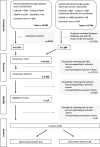How diet, physical activity and psychosocial well-being interact in women with gestational diabetes mellitus: an integrative review
- PMID: 30732571
- PMCID: PMC6367798
- DOI: 10.1186/s12884-019-2185-y
How diet, physical activity and psychosocial well-being interact in women with gestational diabetes mellitus: an integrative review
Abstract
Background: Gestational Diabetes Mellitus (GDM) is associated with future cardio-metabolic risks for the mother and her child. In addition, one-third of women with recent GDM develop postpartum depression. Given these adverse impacts of GDM on the health of the mother and her offspring, it is important to intervene on modifiable factors, such as diet, physical activity, and psychosocial well-being. This integrative review therefore explored evidence on how these modifiable factors interact in women with GDM and their offspring, and how effective combined interventions are on reducing adverse impacts of GDM.
Methods: A comprehensive search strategy included carefully selected terms that corresponded to the domains of interest (diet, physical activity and psychosocial well-being). The databases searched for articles published between 1980 and February 2018 were: CINAHL, PsycINFO, Embase, Pubmed and Cochrane. Studies that were included in this review were either observational or intervention studies that included at least two domains of interest. Articles had to at least report data on maternal outcomes of women with GDM.
Results: The search strategies identified 14'419 citations after excluding duplicates. After screening titles and then abstracts, 114 articles were selected for detailed evaluation of their full text, and 16 were included in this review: two observational and 14 intervention studies. Results from observational studies showed that psychosocial well-being (social support and self-efficacy) were positively associated with physical activity and dietary choice. Intervention studies always included diet and physical activity interventions, although none integrated psychosocial well-being in the intervention. These lifestyle interventions mostly led to increased physical activity, improved diet and lower stress perception. Many of these lifestyle interventions also reduced BMI and postpartum diabetes status, improved metabolic outcomes and reduced the risk of preterm deliveries and low birth weight.
Conclusion: This integrative review showed that psychosocial well-being interacted with diet as well as with physical activity in women with GDM. We recommend that future studies consider integrating psychosocial well-being in their intervention, as observational studies demonstrated that social support and self-efficacy helped with adopting a healthy lifestyle following GDM diagnosis.
Keywords: Exercise; Intervention; Mental health; Nutrition; Pregnancy.
Conflict of interest statement
Ethics approval and consent to participate
Not applicable.
Consent for publication
Not applicable.
Competing interests
The authors declare that they have no competing interests.
Publisher’s Note
Springer Nature remains neutral with regard to jurisdictional claims in published maps and institutional affiliations.
Figures


Similar articles
-
The effect of weight management interventions that include a diet component on weight-related outcomes in pregnant and postpartum women: a systematic review protocol.JBI Database System Rev Implement Rep. 2015 Jan;13(1):88-98. doi: 10.11124/jbisrir-2015-1812. JBI Database System Rev Implement Rep. 2015. PMID: 26447010
-
Improving cardiometabolic and mental health in women with gestational diabetes mellitus and their offspring: study protocol for MySweetHeart Trial, a randomised controlled trial.BMJ Open. 2018 Feb 27;8(2):e020462. doi: 10.1136/bmjopen-2017-020462. BMJ Open. 2018. PMID: 29487077 Free PMC article. Clinical Trial.
-
Women's experiences of a diagnosis of gestational diabetes mellitus: a systematic review.BMC Pregnancy Childbirth. 2020 Feb 7;20(1):76. doi: 10.1186/s12884-020-2745-1. BMC Pregnancy Childbirth. 2020. PMID: 32028931 Free PMC article.
-
Changing psychosocial determinants of physical activity and diet in women with a history of gestational diabetes mellitus.Diabetes Metab Res Rev. 2018 Jan;34(1). doi: 10.1002/dmrr.2942. Epub 2017 Oct 19. Diabetes Metab Res Rev. 2018. PMID: 28843034 Clinical Trial.
-
A review of the health beliefs and lifestyle behaviors of women with previous gestational diabetes.J Obstet Gynecol Neonatal Nurs. 2009 Sep-Oct;38(5):516-26. doi: 10.1111/j.1552-6909.2009.01051.x. J Obstet Gynecol Neonatal Nurs. 2009. PMID: 19883473 Review.
Cited by
-
Association between levels of aquaporin 3 in the placenta and adiponectin in the umbilical cord blood with gestational diabetes mellitus and pregnancy outcome.Mol Med Rep. 2020 Aug;22(2):1498-1506. doi: 10.3892/mmr.2020.11225. Epub 2020 Jun 12. Mol Med Rep. 2020. PMID: 32627013 Free PMC article.
-
Relationship between leisure-time physical activity and depressive symptoms under different levels of dietary inflammatory index.Front Nutr. 2022 Sep 7;9:983511. doi: 10.3389/fnut.2022.983511. eCollection 2022. Front Nutr. 2022. PMID: 36159493 Free PMC article.
-
Effect and Significance of High-Quality Nursing on Blood Glucose, Pregnancy Outcome, and Neonatal Complications of Patients with Gestational Diabetes Mellitus.Comput Math Methods Med. 2022 Apr 26;2022:2426417. doi: 10.1155/2022/2426417. eCollection 2022. Comput Math Methods Med. 2022. Retraction in: Comput Math Methods Med. 2023 Dec 6;2023:9782396. doi: 10.1155/2023/9782396. PMID: 35516455 Free PMC article. Retracted.
-
The Role of Lifestyle Interventions in the Prevention and Treatment of Gestational Diabetes Mellitus.Medicina (Kaunas). 2023 Feb 1;59(2):287. doi: 10.3390/medicina59020287. Medicina (Kaunas). 2023. PMID: 36837488 Free PMC article. Review.
-
Association of a history of gestational diabetes mellitus with osteoporosis, bone mineral density, and trabecular bone score in postmenopausal women.Diabetol Metab Syndr. 2023 Oct 27;15(1):215. doi: 10.1186/s13098-023-01194-8. Diabetol Metab Syndr. 2023. PMID: 37884990 Free PMC article.
References
Publication types
MeSH terms
Grants and funding
LinkOut - more resources
Full Text Sources
Medical
Molecular Biology Databases

